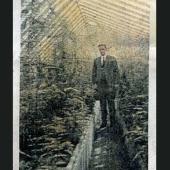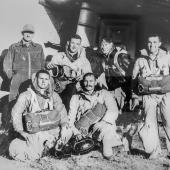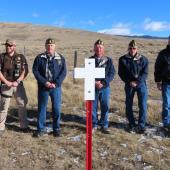The Original Governor's Mansion in Helena
If walls could talk, the Original Governor’s Mansion in Helena would have plenty to say about its three private owners and nine resident governors. These men left their stories behind, each adding a layer to the mansion’s public and private past. Although it was a public building for much of its life, it was never just a house; it was always a home.
Legend has it that the gold rush bred more millionaires per capita in Helena than any other city in the United States. Copper kings and merchant princes left their marks upon the community in grand business blocks and beautifully appointed residences. But the gold rush was a boom and bust proposition. For every fortune won, another was lost. No rise and fall was more dramatic than that of William A. Chessman, the mansion’s first owner.

Chessman was a nineteen-year-old orphan when he left Massachusetts for the California gold rush in 1849. Mining there brought him little financial reward but he gained invaluable experience. Word of gold strikes in Montana drew the seasoned miner to Last Chance Gulch in 1865. In the new gold camp of Helena, Chessman acquired mining claims and valuable water rights. A decade later at forty-five, Chessman married Penelope Newhall and the couple had two children, Frank and Susan; a third died in infancy.
Elected five times to the territorial legislature, Chessman’s fortunes multiplied as he invested in mines in Montana and Idaho. By the late 1880s, his many enterprises included four local hydraulic mining operations, rewashing the placer tailings at Last Chance Gulch. This industry pumped out hundreds of dollars in gold each day. When the gold was depleted, Chessman platted Helena’s Central Addition and sold the real estate. His water rights expanded and he began to supply water to Helena residents.
In 1887, the firm of Hodgson, Stem, and Welter of St. Paul and Helena designed the Chessmans’ stylish home. At a time when apartment living was a growing trend, many viewed the multi-dwelling lifestyle as the antithesis of domesticity. As a result, large homes were intentionally designed with numerous smallish, cozy rooms to keep the family unit together. The Queen Anne style, with its turrets and gables, balconies and tall chimneys, and uneven lines, captured the fancies of the Victorian era and lent itself to the domestic ideal. The Chessmans’ beautiful grounds harmonized accordingly with the landscape.
Completed in 1888, the mansion rests upon a prominent corner. Its graceful wraparound porch—meant to invite and merge with nature—even today is its most striking feature. The ample carriage house, spacious and turreted, set back from Sixth Avenue, housed the family’s vehicles and stabled their horses. Its upper level quartered the family’s coachman.
Inside, the twenty-room showplace reflects the finest craftsmanship. Carved wooden columns, intricate latticework, and a grand curved staircase in golden oak welcome the visitor into the reception hall. There are two parlors, one finished in mahogany and the other in cherry. According to contemporary taste, the furniture in each room matched the woodwork. A dining room with an exquisite semi-circular stained glass window, built-in china closets and sideboard, and a coffered ceiling rival the most expensive homes in the East. The third-floor ballroom had a billiard table that the Chessmans frequently removed for dancing. Penelope Chessman’s studio was also on the third floor. In this room she and her friends painted china, a common hobby of the time. Family bedrooms took up the second floor. Gas lit the home and central heating kept its rooms warm. Even so, seven fireplaces reinforce the Victorian conception of the ideal family home. “Art Tiles” that surround four of the fireplaces reflect the artistic movement of the late nineteenth century.
The home’s major attraction—at least, in its day—was the second-floor bathroom, one of the first three in Helena. Chessman also pioneered home water delivery and his position as water company president no doubt justified this extravagance. The bathroom was equipped with a footed zinc bathtub and a marble washstand, both with hot and cold running water. The tub had a three-inch mahogany rail; the toilet sported a mahogany seat and a pull-chain flush. The Chessman’s son Frank recalled, “For several years whenever the legislature met in Helena, the wives and children would come and ask Mother if they might look at the bathroom, in that they had never seen one.”
In 1889, Chessman sold his assets and created the Helena Consolidated Water Company upon which his financial well-being depended. The Chessman family was at the Chicago World’s Fair in 1893 when the financial panic that ruined many Montanans hit. Personal debt and endless crises with his water company eventually forced the family to declare bankruptcy in 1900, sell their home and furnishings, and move to a flat in their apartment building across the street.
Wealthy railroad mogul Peter Larson purchased the Chessman home from the bank. Like Chessman, Larson was a self-made man, born in Denmark, who rose to prominence contracting with the railroad. Mines, timber, flour mills, a brewery, and banks were among his diverse investments. The Helena community remembers Larson for his generous contributions toward the building of the magnificent St. Helena Cathedral. Margaret and Peter Larson and their twenty-two-year-old adopted daughter Mabel settled into the mansion in 1901. Mabel later married Charles B. Power, son of Senator T. C. Power, Montana’s wealthiest merchant prince. Larson sadly died at the mansion in 1907; he was only fifty-eight.
The home sold again -- to Harfield and Kathryn Conrad in 1911. Conrad was born into Montana’s wealthy elite. Son of W.G. Conrad, who made a fortune freighting at Fort Benton, he inherited his father’s wealth and came to Helena to oversee the Conrad Trust and Savings Bank. During their brief residency, the Conrads added valuable pieces of art to the home.
In 1913, the State Legislature appropriated $30,000 to purchase the mansion for use as the executive residence. Territorial and state governors had previously supplied their own housing. Although the home was no longer in Helena’s most fashionable neighborhood, the state selected the Chessman house because it was close to the Capitol and elegant and roomy enough for small state functions. Governor Samuel V. Stewart signed the bill on March 4, 1913. There were no funds, however, for the state’s purchase, and the Conrads deferred payment for two years.
Governor Stewart and his wife Stella, a former teacher, had three small daughters: Emily, Marjorie, and Leah. Stella’s parents, William and Emma Baker, also lived with the family. The Stewarts and the Bakers, along with the service staff, made for a large household. According to the Stewart daughters’ written reminiscences, staff usually included a cook, a maid, sometimes a nursemaid, and a yardman. The household help lived in rather unpleasant basement rooms, and there was much turnover in staff.
The state allowed $3,000 for the purchase of furnishings from the Conrads. These included the Tobey Furniture Company dining table and high-backed chairs with leather seats that still grace the dining room. It is likely the same set Frank Chessman remembered from his childhood. Ornately carved men hold the table on their shoulders and animal heads with open mouths top the chair frames. Emily Stewart Stephens, the Stewarts’ oldest daughter, said that even though she knew she would be punished, those open mouths “made wonderful places to park a wad of gum.”
Marjorie Stewart Keeton, youngest of the daughters, was four when her father became governor. The girls loved to play outside with the neighborhood children. But their grandmother, a very proper southern lady, always reminded them that they had to look and act like ladies. As the daughters of a politician, they had a “position” to maintain. Their life in the house was very happy. “However,” Marjorie wrote, “we always had to dress up which annoyed us no end.”
Changes came about in the house during Governor Stewart’s administration. Remodeling turned the maid’s room on the third floor into a second bathroom and the ballroom became the girls’ playroom. The Stewart girls kept their dolls and treasures there and entertained their friends. Stella Chessman’s former studio and other third-floor rooms became family and guest bedrooms.
The Stewarts’ middle daughter, Leah Stewart Brickett, had one unpleasant memory of the Chessmans’ early bathroom, still in use by the Stewart family. During a drought in 1917 or 1918, as Stella drew a bath for Leah in the footed tub, a worm came out of the tap. Stella removed the worm and ordered a screaming Leah to get into the tub. The struggles Chessman faced making Helena’s water system safe and sanitary were even at this date not resolved.
As the governor’s executive mansion, the first floor was public space for state functions and entertaining. The upper two floors were very much the family home. Stella Stewart was a loving mother and the daughters recalled with nostalgia that she would put “Schubert’s Serenade” on the victrola in the upstairs sitting room. As the music filtered through the upstairs rooms, the girls knew it was time for bed.
Governor Joseph Dixon and his wife, the former Caroline Worden of Missoula, next occupied the mansion from 1921 to 1924. The Dixons had six daughters ranging in age from six to twenty-four. The John H. Erickson family followed. Grace Erickson wrote in her diary in 1932 that climbing through the second-floor bedroom window to hang the American flag over the porch was a terrible trial, and the flagpole had to be stored behind the governor’s bathtub. On warm summer evenings, when the porch served as an extra room, Governor Erickson was fond of staying outside in the swing until long after the household had turned out the lights.
Seven more governors occupied the mansion. In 1952, the local newspaper noted the once-red carpet had become nondescript and the mansion’s elegance had faded, “Heavy, ornate furniture that is probably as old as the house itself has become loose at the joints.” In 1959, Governor Hugo Aronson moved from the mansion to the present modern executive residence at 2 Carson Street. The old residence, for the first time in its history, had no family to fill its twenty rooms. Dark and shuttered, it sat empty or used as office space for a decade.
In 1969, with the support of the City of Helena, restoration of the mansion began. Since 1981, the Montana Historical Society, through its museum program, has administered the historic mansion as a house museum. Its beautifully restored and furnished rooms date to the time period of the Stewart family’s residency. Under the society’s museum director, the fourteen-member Original Governor’s Mansion Restoration Board helps preserve the building and grounds by providing opportunities for fund raising, mansion tours, and special occasions on the grounds. Its longest running event is the Annual Original Governor’s Mansion Holiday Home Tour, a popular seasonal event since 1980.
As with any old house, there is always something needed. One recent restoration project entailed replacement of wall coverings in the guest bedroom. The replica fabric came from Italy at a cost of $10,000, raised by the Board through private donations.
The carriage house, open during the summer months, houses a handsome collection of historic conveyances. One belonged to Marcus Daly and another charming carriage belonged to madam Lilly Ashton, the one-time proprietress of Helena’s infamous “Castle.” The delicate vehicle was reputedly a gift to Lilly from the English Duke of Belmont. Gold initials, “L.A.,” identify the carriage as hers.
The mansion, listed on the National Register of Historic Places, is open for tours year round. Its period rooms and furnishings offer a glimpse of another time and a window into the public and private spaces of Montana’s past. Governor Stewart’s executive secretary once wrote that the mansion is “a home of democracy…a plain American home, if you please.” While its beauty and grandeur speak to the wealth that gold could buy, family is at its heart.
~ Ellen Baumler is the interpretive historian at the Montana Historical Society in Helena. Although best known for her tales of Montana’s haunted places, collected in Spirit Tailings and Beyond Spirit Tailings, she is also a teacher, lecturer, and popular tour guide of Helena’s historic landmarks. Ellen is co-author with Dave Shors of Lost Places, Hidden Treasures, a photographic history of Helena, Montana.












Leave a Comment Here